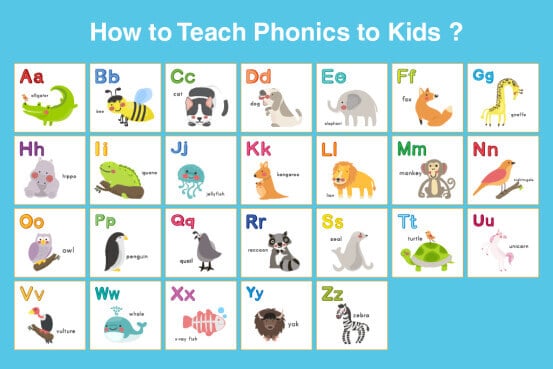A Guide on How to Teach Phonics to Kids
Phonics has deep roots in our education system, and while many see phonics as a separate subject, that isn’t the case. As a parent of a child learning to read, chances are you’ve been hearing a lot about phonics.
So, what exactly is Phonics?
Simply put, phonics is an essential stepping stone that can help children in their early years of language development and comprehension aptitude. There are exclusive institutes that offer phonics courses for kids. However, as parents, if you want to learn how to teach phonics to kids, then this article can help!
Unlock your teaching potential and help your child succeed in phonics learning. Join us and learn how to teach phonics to kids!
What is Phonics?
Phonics is a method of teaching children to read by linking phonemes (sounds) and the symbols that represent them. As the name suggests, phonics is related to sound. The mouth can make several sounds, and many of them play a vital role in creating the languages that we speak today.
These sounds represent letters, and the connection between them is what phonics aims to explore. Phonics provides kids with the tools they need to decode new words, which can help them learn new languages speedily.
Importance of Phonics For Kids
It is vital that when kids learn to read and write, they also discover how to form words and understand what they mean. All this should be done systematically for them to speak at a normal pace. These skills are related to comprehending the language, which is where phonics can help.
Phonics sounds for kids help unlock their ability to read unfamiliar words easily, unlike the sight-word method based on memorization. Eventually, as the kids step-up to an advanced level, they will be able to blend letter sounds without stumbling over every word. It allows children to quickly pick up the syllable structure, which helps them become strong readers.
Enrol in our Jolly Phonics Workshop for teachers and parents if you want to teach phonics to kids at home.
How to Teach Phonics to Kids?
1. Start With Common Sounds
Phonics revolves around letters in written words and their relationship with the individual sounds in spoken words.
The first step in teaching phonics to beginners is to introduce them to the simple alphabetical code, which helps them learn the sounds associated with each letter.
Simple Alphabetical Code Examples

It is also vital to avoid confusion between letter sounds and their names.
For instance, the letter ‘d’ represented in the words ‘duck’ or ‘desk’ is quite different from the letter name, which sounds more like ‘dee’.
We suggest you avoid using letter names in the early stages of phonics as it might hinder the ‘learning to read’ process. Also, it may interfere with their attempts at spelling the word right.
You can teach your child letter names, later on, just tell them that each letter has a sound as well as a name, and right now, we are focusing on the ‘sound’ aspect.
2. Teach Them the Sounds of Letters
The next step in how to learn phonics sounds is to familiarise your child with the sounds of the letters. This includes the sounds that letters or a group of letters make.
For example, “ey” as in key or “th” as in thin, or “ng” as in think
Teaching them the sounds of letters can be challenging as young children (toddlers) find it difficult to learn abstract things.
3. Teach Them to Blend Words
Once the child is good at recognising the sounds of letters, teach them to blend the sounds and pronounce the whole word.
For example, you can introduce the letters: ‘c’, ‘a’, ‘t’, ‘s’, ‘i’, and ‘p’ and teach them to say ‘cat’ and ‘sip’.
This is a huge step for kids and can take time. So, always begin with simple words like ‘up’ or ‘at’ or 3-letter words like ‘hot’ or ‘box’.
4. Teach How to Decode Words
✔️ CVC Words
CVC words are words in the arrangement of consonant, vowel, and consonant. They begin with letter sounds such as the consonants b, g, h, d and the remaining vowels e, o, u. You can give them letter cards that they can put together to make CVC words and ask them to say them out loud.
✔️ Consonant Clusters (CCVC & CVCC)
Move on to easy 4 letter phonetic words once they are done with CCVC and CVCC words. Consonant clusters are two consonants located together in a word, such as cr, tr, lk, st, and pl. Some CCVC and CVCC words are trap, plan, stop, milk, fast, and cart.
✔️ Vowel Digraphs
Introduce children to vowel digraphs once they have picked up CVCC and CCVC words. A digraph is two vowels linked together, making it sound like one, such as – oa, ee, oo, and ai.
For example, boat, deer, book, and hair.
This will also help them read words combining vowel digraphs with consonant clusters such as groan, stool, train, and others.
✔️ Consonant Digraphs
The next step is to teach the consonant digraphs, i.e. two consonants together make one sound. Examples of words that contain ch and sh alphabets are – chat, shout, chain and shop.
5. Words That Do Not Follow The Phonics Rule
Learning to recognise sight words generally means memorising words that do not follow the phonics sound words. Sight words aren’t meant to be taught to infants and toddlers.
The English language has so many exceptions. For instance, “ai” usually makes the sound of ‘a’ or ‘ay’. But, when saying the word, it makes the sound of ‘eh’.
6. Spell and Read Loudly
Along with learning to read phonic words, children should also practise writing and spelling simple words correctly. Reading through age-appropriate texts will often encourage kids to read loudly and spell well.
Read: Phonics learning for kindergartners
Phonics For Kids: Activities That Can Help
1. Word Games
Language-based games are your best friend when it comes to teaching your kid about phonics. Play the letter connection game with them. In the game, give them a word and ask them to use the last letter to make a new word. This will help create connections, helping them to use letters appropriately.
2. Read Loudly Daily
During the early stages, kids cannot read as fast as they can speak. Even if they try to read, they cannot read quickly.
Here, you can teach your child to use their index finger and place it under each word as they attempt to read it aloud.
It will help them put the sounds of the letters together, allowing them to read words they don’t know. Such activities make use of phonics, making kids aware of how they can use words. Gradually, they can move beyond their textbooks.
To do this, you need to:
✔️ Inculcate the habit of reading in children from an early age.
✔️ Make them read the headlines of the newspaper daily
✔️ Let them pick out a storybook, and both of you can read it together.
Reading aloud daily will help them learn new sounds and new words quickly.
3. Picture-talking
Tap into the child’s creative mindset when taking them out on a phonics adventure. Ask them to spot objects that start from A to Z. This activity will help capture their attention on a vacation or a field trip. You can even continue this at home with an alphabet book.
4. Watch Phonics Videos
If your kid isn’t in the mood of reading from a book, you can still teach them by showing phonics videos. Watch videos and talk about them later to test their memory recall.
5. Use Worksheets
Make good use of your resources and print worksheets for your child. This is a basic phonics activity that helps them learn each letter and its sound. As they turn more confident with letters, this activity can be done by them without adult supervision.
Read: 20+ Fun Phonics Activities and Games for Early Readers
Unlock your teaching potential and help your child succeed in phonics learning. Join us and learn how to teach phonics to kids!
Conclusion
Phonics is a vast subject that requires special skills to be able to teach. However, these pointers are a good place to start if you want to teach your child some basic phonics at home. Persistence, practice and patience are the three ‘Ps’ that parents need to follow if they want their children to read, write and speak well. So, make the best use of this guide. You can also click here to learn more about the different phonics classes for kids.
Additionally, if you have any queries, don’t hesitate to get in touch with us today!

Hema Dave
Stemming from the aspiration to nurture and inspire young minds, Hema started her professional journey into education 20+ years ago. She founded 'Phonic Smart' as a trained educationist, an institute committed to equipping children with phonics skills and helping parents and teachers implement them effectively. Her diverse skill sets, encompassing teaching, teacher training, and coaching allow her to contribute valuable insights to the education industry.

